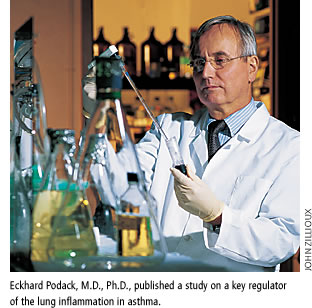 The great irony of asthma is that breathing problems erupt because the body is fighting to protect itself. The great irony of asthma is that breathing problems erupt because the body is fighting to protect itself.
It starts with an immune response to an allergen, like smoke or pollen, or to exertion or stress—even to a common cold. In an instant, T-helper cells (Th2) and CD4 cells are activated and interleukin-13 is produced, causing the airways to swell.
Researchers at the Miller School have identified a receptor/ligand pair—which are bonding molecules—and play a critical role in the first signals to the Th2 cells, starting the inflammation. And they may have a way to stop it.
Eckhard Podack, M.D., Ph.D., professor and chair of microbiology and immunology, was the lead author of a study published in May in the Journal of Experimental Medicine describing the role of the receptor/ligand pair (tumor necrosis factor receptor superfamily 25/TNFSF15) in lung inflammation.
“It’s a very important regulator of inflammation in the lung,” says Podack. And it both fuels inflammation and inhibits the body’s response. “Think of it as a gas pedal and the loss of a braking system.”
Podack is working with other researchers and UM’s Wallace H. Coulter Center for Translational Research on a promising targeted therapy. To date, one of the best ways to target certain molecules has been through antibodies, but they’re expensive and difficult to get FDA approved.
“So we are also developing this new platform technology called aptamers,” says Eli Gilboa, Ph.D., Dodson Professor of Microbiology and Immunology and director of the Dodson Interdisciplinary Immunotherapy Institute. “Unlike antibodies that have to be manufactured in cells, a complicated and expensive method, aptamers can be generated in a relatively simple and cost-effective chemical process.” The hope is that custom-made aptamers can be made to target this particular receptor/ligand pair—and to treat asthma and other ailments. |


